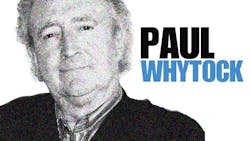White Space: The First Frontier For The “Internet Of Things”
White-space communication, also known misleadingly as Super Wi-Fi, is rapidly gaining ground throughout Europe. In the U.K., the Weightless Open Standards Group aims to kick-start the Internet of Things via white-space communications, saying that it will deliver its first complete specification in the opening quarter of 2013.
In fact, mobile wireless-data service provider Neul just issued version 0.9 of the Weightless Specification. The company deployed what it claims is the world’s first city-wide, fully functional wireless network in white space in its home city of Cambridge, England.
So, what’s misleading about the name Super Wi-Fi? Perhaps it’s because white-space communication isn’t based on Wi-Fi technology. Rather than use the 2.4GHz radio frequency, white-space communications employ lower-frequency white spaces between television channel frequencies. These allow signals to travel further and penetrate walls better than higher frequencies.
White spaces refer to frequencies allocated to a broadcasting service. This allocation process creates a bandplan that assigns white space. However, these white spaces typically exist naturally between used channels. In addition to these, there’s also unused radio spectrum, which has either never been used or become free. The switch from analogue to digital TV is a case in point—large areas between about 50 and 700MHz became available.
French Initiative
French communications research centre CEA-Leti, which has developed opportunistic radio technologies (or cognitive radio) since 2005, was just granted a government license to experiment with television white-space equipment in the field.
To reiterate, white space is the unused or underused parts of the wireless spectrum. Usually, many TV channels are left vacant. White-space communications technology aims to open these up, as well as allow underused frequencies within other UHF licensed and unlicensed bands to be employed for wireless communication.
What prompted the French government to issue a license to CEA-Leti was the research and development of wireless cognitive radio systems done by the centre’s Communication and Security Department (STCS). Cognitive radios not only allocate, but also exploit, spectral resources to optimise the capacity and capability of wireless communication networks.
However, at this time, France doesn’t permit dynamic spectrum management. Nonetheless, because it’s perceived as an efficient means to de-saturate the crowded radio spectrum, industry experts expect permission to be given at some point.
The U.S., on the other hand, is on the other side of the fence. Unlicensed opportunistic spectrum usage has, in fact, been authorised in the free channels of the television spectrum or television white space.
Current studies are evaluating whether a similar paradigm could be applied in Europe, for instance in the framework of the European Conference of Postal and Telecommunications Administrations. The technology developed by Leti can be applied in both Europe and the U.S.
The STCS’s cognitive radio research focuses on two fundamental issues related to dynamic spectrum access: Free-channel detection, and flexible high-spectrum-efficiency communication systems with low power leakage in the adjacent channels (known as adjacent-channel leakage ratio).
Challenging Environment
In Cambridge, Neul’s network builds upon the completion of the first phase of the Cambridge White Space Consortium’s wireless network. The network uses Neul’s equipment and cloud interface, together with the Weightless communications standard, to prove that its white-space network coexists with televisions and wireless microphones without causing interference or disruption.
City space does create a challenging propagation environment. More than 120dB link loss occurs through buildings, foliage, walls, furniture, and, of course, human beings.
Neul believes its network opens up several possibilities for the Smart City of the future, enabling intelligent transport and traffic management, city lighting, and other municipal services.
Licensing of spectrum space remains a key issue in wireless communication. In the U.K., though, national communications regulator Ofcom said it would not seek to license access to the spectrum relative to white-space communication. It also expects the first examples of white-space technology to come online in 2013.
